BAV Caracas (AC/BC-1908 (TS-1934))
Back to Venezuelan Navy page:
Before Wrangel's Fleet came to the attention of the Venezuelan Admiralty and
Government, a period of expansion of the armed forces of Venezuela was underway.
When the Venezuelans were offered four Battlecruisers with a free refit by the
Americans, the Venezuelans jumped
at the chance to obtain four such modern ships at a price they could afford. The
four ships (of a class of eight) were the last American armoured cruisers and
followed the practice of inline superimposed turrets introduced by the South
Carolina Class. The four funnels of the previous Pennsylvania class were reduced
to two because of the turbine machinery, giving a much more sleek profile. This was the first class of large ships completed with turbine
machinery. The Washington Treaty meant these ships would have had to be classed
as Capital Ships, so out they had to go. America kept two and also converted
them to training carriers.
Barely had the four ships arrived in Venezuelan waters and their new crews being
trained to take over from the American Navy 'caretakers' that had sailed the ships
from New York where the ships had been refitted, than news of the Wrangel's Fleet
arrived in Venezuela. These four ships were dispatched to meet the Fleet at
Gibraltar in early 1921. This was done as the four new Venezuelan
Battlecruisers would be able to help shepherd the rag tag fleet across the
Atlantic and insure no interference from any Soviet ships sent out from the
Baltic to intercept the fleet. As it turned out the Soviets while hating the
'escape' of so many czarists was in no position to order anything after the
fleet. That news notwithstanding the four new Battlecruisers had paid for
themselves in their protection of Wrangles Fleet. The actions of the Venezuelan
Navy to help protect the fleet was not lost on the White Russians who may have
been uneasy about the welcome they may receive to their new 'home'. This helped
the smooth integration of the White Russians into Venezuelan society and led to
the expansion of Venezuela into its neighbouring countries.

With the arrival of Wrangel's Fleet the position of these four ships as the
'Pride of the Fleet' fell a few notches as the Battleships and cruisers brought
with the fleet were their equals and betters. The further expansion of the fleet
during the 1920's and 30's left these two ships getting older and less useful.
After 15 years service it was these four ships turn to be turned into
miscellaneous
ships and give up a part of their armament for the production of three new cruisers (see
BAV Falcon). Two of the
four followed the new British practice of Area Defence Vessels while the other
two were to become training carriers for the fleet, one in the Pacific, the
other in the Caribbean.
.png)
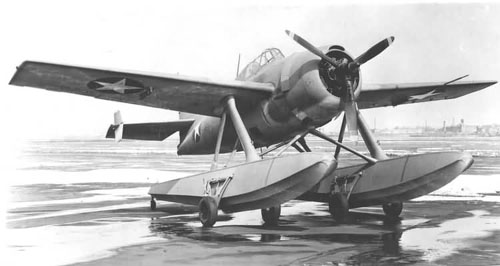
The first fighters carried on the Area Defence Vessels was a biplane conversion.
That was superseded in service by the Wildcat on floats. A great advance in
capabilities.
The front pair of 10" turrets were retained. Half of the boiler rooms were
removed and converted to other uses, which still gave a speed of about 18 knots
(on a good day). The replacement 5.1" single guns were locally made and replaced the US
pattern 5" the ships had arrived with. In the 15
years since Wrangel's fleet had arrived, Puerto Cabello had been improved to the
point where the armoury was producing up to the 5.1" guns and the local shipyard
was producing its own destroyers and escorts. Heavy armour was still outside its
capabilities and full capital ships still had to be sourced from the Americans.
But all of the infrastructure was in the process of being completed. Domestic
large capital ships were not far away.
These two ships spent their war as training ships and escort cruisers, while undertaking the task of
convoy duties to the tankers that went from Maracaibo up to Newfoundland. Being
able to supply some air cover was a real blessing.
.png)
The last pair of cruisers were to become training carriers for the Venezuelan
Navy. Venezuela had ambitions to build a Fleet of these new ships and the
Caracas type carriers would train the pilots to man the aircraft aboard them.
The two best of the four cruisers were to be converted to carriers while the
other two were converted to Area Defence Vessels. The extra above waterline
weight meant that the ships had to be fitted with bulges to maintain stability.
The original machinery was kept and provided enough speed for the ships to act
with the fleet when necessary. The bridge superstructure and many other items
were copied from Venezuela's first aircraft carrier as the navy yard still had
the plans that had been provided for them by the Fore River Yard in the US.
| Displacement |
15,800 tons std 18,400 tons full load |
| Length |
560 ft |
| Breadth |
78 ft |
| Draught |
26 ft |
| Machinery |
2 shaft steam turbines 45,000shp, (20,000shp
ADV) |
| Speed |
25 knots (ADV 18 knots) |
| Range |
8,000 miles at 12 knots |
| Armour |
7" side armour, 2" deck armour |
7" side armour, 2" deck armour |
2" deck armour, bulges fitted, |
| Armament |
As Armoured/Battle Cruiser
8 x 10" (4x2)
10 x 5" (10x1)
6 x 3" AA (6x1) 1917
6 x 3" LA (6x1)
|
As Area Defence Ships
4 x 10" (2x2)
4 x 5.1" (4x1)
6 x 3" AA (6x1)
6 x 40mm (3x2)
10 x 20mm (10x1)
|
As Escort Carriers (CVE)
4 x 3" AA (4x1)
12 x 0.5" mg (12x1)
replaced with 20mm 1940-41
|
| Aircraft |
nil |
8-9 depending on size and type |
22 |
| Complement |
1015 |
975 |
1150 |
| Notes |
BAV Caracas
BAV Valencia
BAV Maracay
BAV Barcelona |
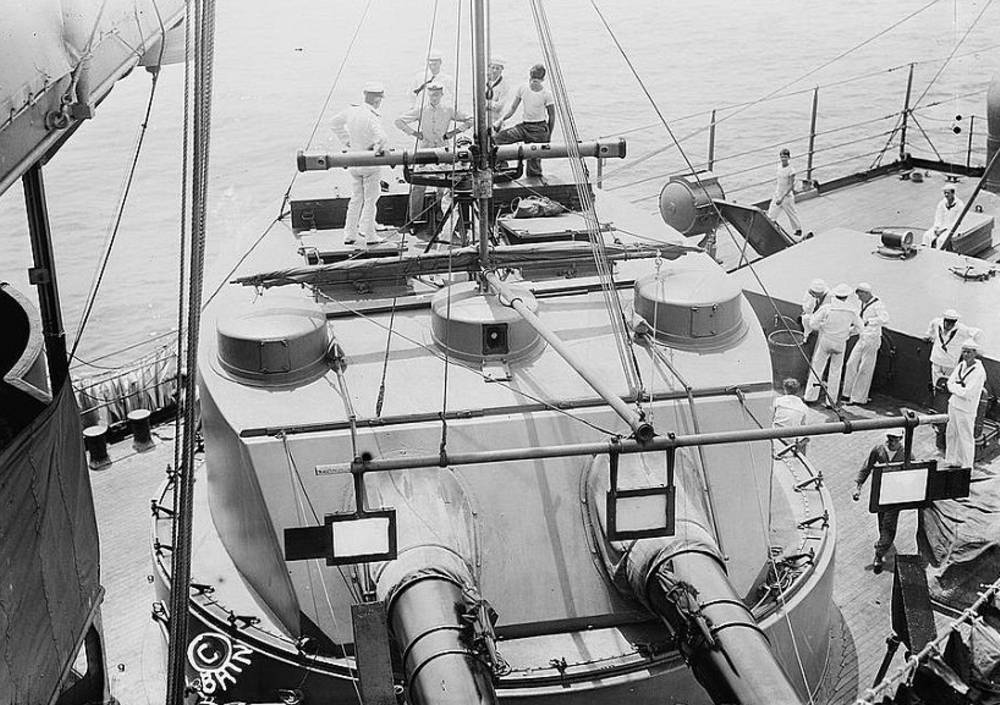
Aft turret of Caracas circa 1920 handover.
Below are the leftover drawings and notes from 2012.

Above and below were my second tries at sourcing armoured cruisers /
battlecruisers from US sources. The bottom two drawings were the original
efforts.

With the Royal Navy doing its best to sew up Brazil and Chile for ship sales
and replacements, this left the northern South American nations open to US Navy
influence. While Venezuela did not really need large ships, prestige and
National honour does come into purchases for your naval vessels. When the US
Navy, in 1919, offered two of the Tennessee class armoured cruisers for virtually scrap
price plus a cheap refit price the Venezuelan Navy jumped at the chance of
adding two large ships at a price they could afford.
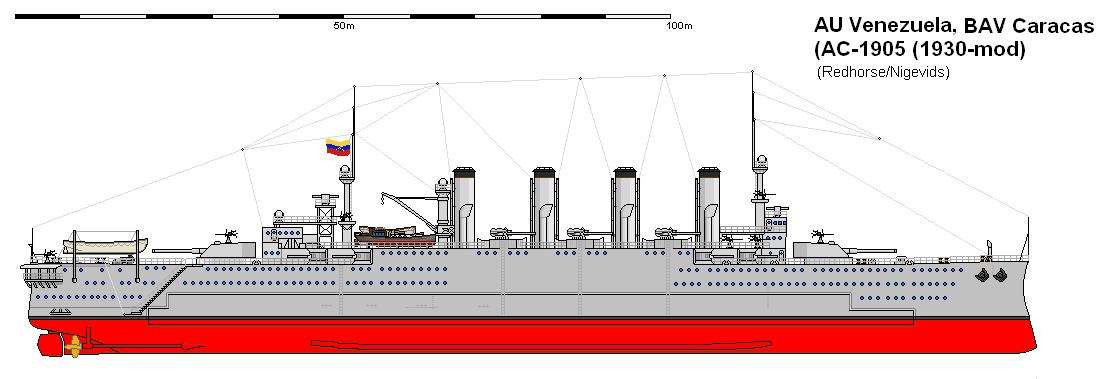
After 5 years of service (to 1925) the Venezuelans looked at what could be
done to improve the ships and keep them in service through to age 30+. The
Venezuelans being a producer of oil, the conversion of the ships to oil firing
made sense. One of the updates the US Navy yards offered for the ships was the
upgrading of the engines boilers to a plant of 55-60,000 SHP that would not
change the layout of the current drive train. This would increase the speed of
the ships from 22 knots (on a good day) to 25-26 knots. The major difference is
with the upgraded turbine machinery the speeds could be maintained for days on
end, while the current reciprocating engines could only maintain full speed for
about an hour at a time.
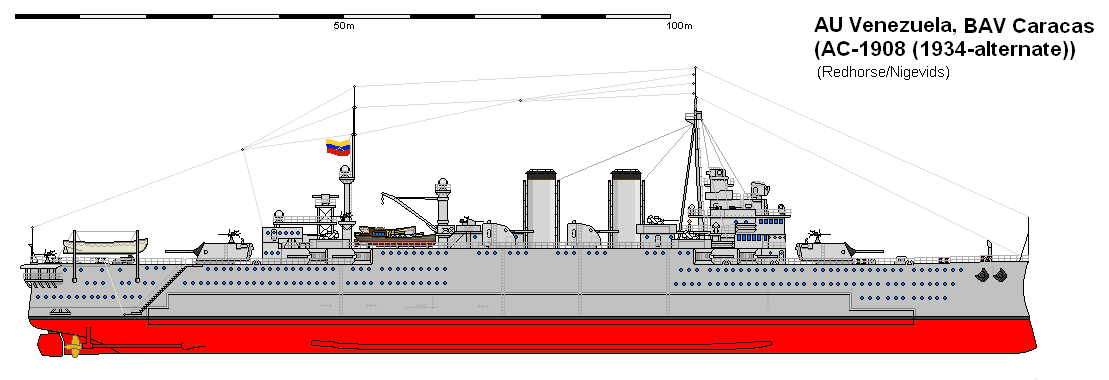
Various gunnery upgrades were also offered to the Venezuelans for these
ships. The first was to keep the two twin 10" guns, fit another 4 x 10" in
single casemates to replace the single 6" casemates and end with a uniform
armament of 8 x 10". While this was a reasonable idea that looked good on paper,
the single 10" casemate guns would have to be manually serviced and ammunition
supply / magazine would require a lot of work. The second was to fit 2 triple 8"
turrets (same as Pensacola type) in place of the 10" turrets. The idea was
either to keep the single 6" and have a mixed armament (shell splashes at long
ranges become a problem) or replace the single 6" with single 8". Again the
single 8" become a problem with manual shell handling. There is a big jump from
a 100-105lb 6" shell to a 250lb+ 8" shell. The 3rd option was to fit two new
triple 6" turrets in place of the 10" and retain the single 6" to give a uniform
armament of 14 x 6" with 10 guns per broadside being available.
| Displacement |
14,500 tons std 17,800 tons full load |
| Length |
504.5 ft |
| Breadth |
73 ft |
| Draught |
25.5 ft |
| Machinery |
2 shaft steam turbines, 57,500shp
2 shaft reciprocating 22,000ihp orig |
| Speed |
26 knots (22 knots orig) |
| Range |
5000 miles at 15 knots (2,200 nm at 25 knots) |
| Armour |
5" side, 3" deck, 5" turrets |
| Armament |
Original 1922 refit. 4 x 10" (2x2)
8 x 6" (8x1)
6 x 5" (6x1) 12 x 0.5" mg (12x1) |
6" US Upgrade 1934+ 14 x 6" (2x3 8x1)
8 x 5" (4x2)
8 x 40mm (4x2)
10 x 20mm (2x2 6x1) |
| Aircraft |
nil |
| Torpedoes |
nil |
| Complement |
860 |
| Notes |
BAV Caracas (ex Montana-1908) BAV
Apure (ex North Carolina-1908) |
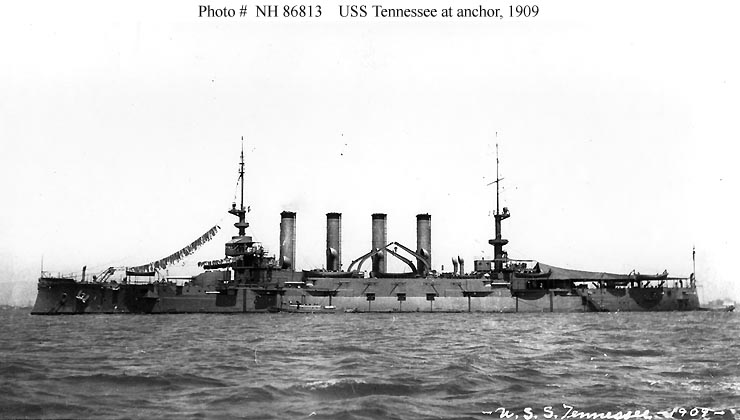
Lead ship of the Tennessee class showing the original armament layout. All of
the lower deck 6" and 3" casemate guns were removed and plated over with only 2
of the single 6" being resited at main deck level.
Back to Venezuelan Navy page:

.png)

.png)

